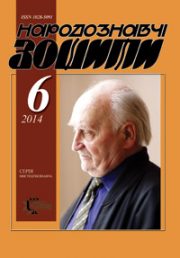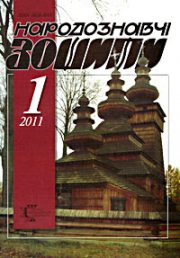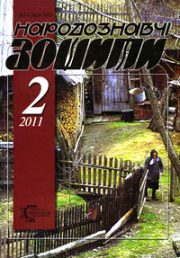The Ethnology Notebooks. 2020. № 5 (155), 1071—1080
UDK 379.85(477.74)
DOI https://doi.org/10.15407/nz2020.05.1071
THE ROLE OF TOURISM IN POPULARIZING THE CULTURAL HERITAGE OF BOYKIVSHCHYNA
KOROBEINYKOVA Yaroslava, NYKODIUK Olha
- ORCID ID: http://orcid.org/0000-0002-4882-8611
- Ph. D., Associate Professor; higher education seeker,
- Ivano-Frankivsk National Technical University
- of Oil and Gas, Department of Tourism
- Contacts: yaroslava.korob@gmail.com; olhanykodiuk@gmail.com
Abstract. The article substantiated the positive role of tourism in popularizing the cultural heritage of Boykivshchyna.
Problem Statement. Cultural heritage is a vital resource for the prosperity of local and regional development, including tourism. Tourism can be considered as an effective factor that contributes to the acquaintance with cultural heritage. Therefore, research aimed at developing methodological bases for balanced interaction of cultural heritage management processes and development of tourism activities based on its use is relevant.
The purpose of research: based on the analysis of demand for ethnic products of Boykivshchyna to substantiate the importance of tourism in the promotion of cultural heritage of Boykivshchyna and to suggest forms of their use in tourism. The object of research is the totality of the cultural heritage of Boykivshchyna as a tourist resource. The subject of research is forms of involvement of elements of cultural heritage of Boykivshchyna in tourist activity.
Methods. Based on the analysis of the google trend search engine, the interest in Boykivshchyna as an ethnographic region among domestic and foreign potential tourists was revealed. Elements of cultural heritage are of interest, including samples of folk art. The positive and negative aspects of the use of cultural heritage in tourism and the role of territorial communities in the promotion of elements of cultural heritage are analyzed.
Results. The authors proposed forms of using elements of tangible and intangible cultural heritage in tourism on the example of Boykivshchyna: holding ethno-festivals, organizing tours, conducting master classes on the production of applied arts in museums and cooking traditional dishes in restaurants, organizing animation programs with elements of folk art.
Conclusion. Preservation of cultural heritage and its rational use are crucial for the sustainable attraction of tourist flows and the improvement of socio-economic indicators of the regions. The database can be used by all stakeholders and beneficiaries of cultural heritage and tourism activities: tourism entities, local governments, managers in the field of culture and preservation of monuments. The intensification of ethnographic tourism throughout the Boyko region can contribute to the rise of other sectors of the tourism industry and will certainly have a positive impact on the preservation and reproduction of cultural heritage.
Keywords: сultural heritage, Boykivshchyna, ethnographic tourism, tourist resource, web search engine, stakeholders.
Received 5.10.2020
REFERENCES
- Kvartal’nov V.A. (1999). Strategic management in tourism: modern management experience. M: Finanse and statistiks [in Russian].
- Mazuryk Z.V. (2006). Cultural heritage of the region as a tourist product. Visnyk DITB. Seriia «Ekonomika, orhanizatsiia i upravlinnia pidpryiemstvamy» (v turystychnij sferi), 10, (178-182) [in Ukrainian].
- Batchenko L. V. & Blyzniuk I. O. (2018). Cultural values as a factor in the competitiveness of the tourism industry. Intangible cultural heritage as a modern tourist resource: experience, practices, innovations: tezy dopovidej II Mizhnar. nauk.-prakt. Konf. festyval’, Kyiv [in Ukrainian].
- Voroshylova H. O. & Zlydenna M. S. (2018). Tourism and cultural heritage: problems and interactions. Intangible cultural heritage as a modern tourist resource: experience, practices, innovations: tezy dopovidej II Mizhnar. nauk.-prakt. konf.festyval’, Kyiv [in Ukrainian].
- Global code ethics tourism. Retrieved from: http://ethics.unwto.org/en/content/ global-code-ethics-tourism (Last accessed: 19.04.2020).
- Rubinshtejn A.YA. (2016). Actual problems of the economy of cultural heritage. Moskva: Gosudarstvennyj institut iskusstvoznaniya [in Russian].
- Hans’kyj V.O. (2018). Commercialization of historical and cultural heritage resources in tourism: mechanisms, limits and barriers. Ekonomika ta upravlinnia natsional’nym hospodarstvom, 15 (95 — 99) [in Ukrainian].
- On the principles of state regional policy: Zakon Ukrainy vid 5 liutoho 2015 r. № 156-VIII. Vidomosti Verkhovnoi Rady Ukrainy. 2015. № 13 [in Ukrainian].
- Preservation and sustainable development of the Carpathians. A textbook on sustainable tourism. URL: http://www.dobrobut-hromad.org/wp-content/uploads/2016/01/Staly_rozvytok_Karpat.pdf (access date: 20.04.2020) [in Ukrainian].
- Harrison Linn S. Development of tourism in historic towns: a reason for reflection. Official site of the Institute for Social Change Management. Retrieved from: //www.istc.biz/index. php?id=12&cons=1&N=2 (Last accessed: 19.04.2020) [in Ukrainian].
- Ripkem D. (2006). Economy of historical heritage. Practical guid. M.: Bilding Media Group [in Russian].
- Yakhina T.R. (2004). Economic assessment of territorial resources of historical cities of Ukraine (on the example of the historical city of Poltava). The thesis for the academic degree of Doctor of Economical Sciences Lviv. Kharkiv [in Ukrainian].
- Association of Ukrainian Cities. Retrieved from: https://2.auc.org.ua/page/krashchi-praktiki (Last accessed: 22.04.202) [in Ukrainian].
- Korniienko V. Current state and problems of using archeological monuments in tourism. Historical and geographical research in Ukraine. Retrieved from: http://resource.history.org.ua/cgibin/eiu/history.exe?I21DBN=EJRN&P21DBN=EJRN&S21REF=10&S21CNR=20&S21STN=1&S21FMT=ASP_meta&C21COM=S&2_S21P03=IDP=&2_S21STR=geo_2006_9_373 (Last accessed: 22.04.2020) [in Ukrainian].
- Antonenko V.S., Balaban N.M., Kovtun M., & Sarapukha B.A. (2018). Folk crafts and handicrafts in Ukraine as a tourist resource. Intangible cultural heritage as a modern tourist resource: experiences, practices, innovations: tezy dopovidej II Mizhnar. nauk.-prakt. konf.festyval’ [in Ukrainian].






